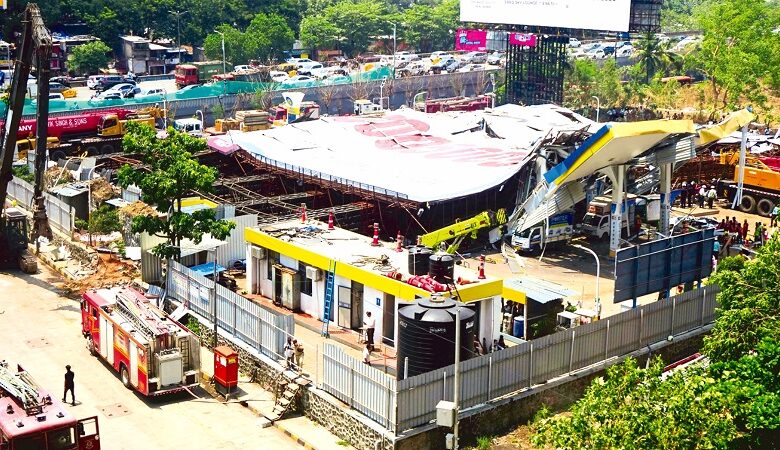Billboard Collapse in Mumbai Raises Concerns Over Urban Safety Standards

News Mania Desk / Agnibeena Ghosh/23rd May 2024
In the bustling metropolis of Mumbai, where towering skyscrapers and bustling streets define the urban landscape, an inconspicuous yet crucial aspect of city life recently came under scrutiny with dire consequences. A colossal billboard, stretching 120 feet by 120 feet, nestled in the heart of Ghatkopar, seemed to blend into the city’s cacophony, its purpose seemingly fulfilled by showcasing advertisements for various brands. However, on the fateful day of May 13, amidst a tumultuous storm, this seemingly innocuous structure met a tragic fate, collapsing and claiming the lives of 16 individuals in its wake.
The aftermath of this calamity reverberated across the city, prompting swift action from authorities and igniting a discourse on accountability and urban development norms. In the wake of the incident, the director of the media company responsible for the billboard found themselves in the crosshairs of law enforcement, facing arrest for their alleged negligence. Concurrently, the Chief Minister of the state wasted no time in issuing directives for a comprehensive structural audit of all hoardings dotting the cityscape, underscoring the urgency of ensuring public safety.
Amidst the flurry of responses from authorities and stakeholders, a prominent voice emerged, advocating for a deeper introspection into the systemic issues at play. Renowned historian and urban analyst, whose expertise spans the intricacies of city planning and governance, emphasized the critical importance of holding the state accountable in such instances. Reflecting on the broader significance of safety audits and urban development norms, the historian offered insights into the underlying dynamics shaping urban life.
“When we interact with the city and its infrastructure, we trust the state with our lives,” the historian asserted, highlighting the implicit contract between citizens and the governing apparatus. Indeed, every aspect of urban existence, from commuting on state-built railways to navigating sidewalks regulated by municipal authorities, underscores this symbiotic relationship. In essence, the city’s infrastructure serves as the tangible manifestation of governance, shaping the everyday experiences of its inhabitants.
Central to this discourse is the fundamental notion that the quality of urban infrastructure directly correlates with the quality of life for residents. The safety and integrity of structures, whether it be bridges, power lines, or advertisement hoardings, are emblematic of the state’s commitment to safeguarding its citizens. As the historian aptly noted, the efficacy of audits and regulations lies in their ability to mitigate the inherent risks associated with infrastructural deficiencies, thereby ensuring public safety.
Moreover, the tragedy in Ghatkopar serves as a poignant reminder of the precarious balance between development imperatives and regulatory oversight. In the relentless pursuit of progress, urban centers often grapple with competing interests, where commercial viability collides with public welfare. However, as the historian cautioned, prioritizing profit over safety is a perilous gamble that can exact a heavy toll on human lives.
As Mumbai grapples with the aftermath of this devastating incident, there exists an opportunity for introspection and reform. Beyond the immediate measures of conducting structural audits and enforcing regulations, a broader dialogue on urban governance and accountability is imperative. The historian’s clarion call to hold the state accountable resonates deeply, underscoring the need for a paradigm shift in how cities approach development and safety.
The tragedy of the collapsed billboard in Ghatkopar serves as a somber reminder of the complex interplay between urban infrastructure, governance, and public safety. As investigations unfold and remedial measures are implemented, the historian’s words reverberate as a clarion call for systemic change. Only through collective introspection and concerted action can cities like Mumbai aspire to create safer, more resilient urban environments for all inhabitants.






